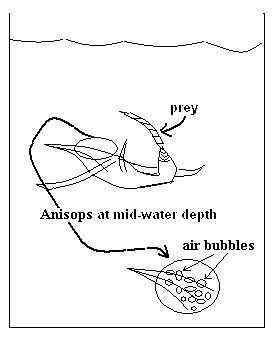Blood component helps insect float.
-S. Ananthanarayanan
The backswimmer is a remarkable insect that uses blood haemoglobin for buoyancy, reports S.Ananthanarayanan. The journal,
Nature carried in its May issue an account of this insect, which has the name,
Anisops, that lies in wait for prey in the mid-water depth!
Most of us know that it is the haemoglobin in our blood that carries oxygen from our lungs to the body cells, and brings the carbon dioxide back to the
lungs, to breathe out. But insects have no lungs and so the blood needs no haemoglobin. In fact, in the place of circulatory system to carry blood and oxygen around, most insects have ‘internal airways’, to let the body cells get their oxygen all by themselves!
Haemoglobin
This is the component of blood that handles the give and take of oxygen from and to the cells and the lungs. Its molecular structure is rich in atoms
of iron, which have affinity for binding with oxygen atoms when these are around, like in the lungs. But when they reach cells that have been using up energy, which comes from burning carbon, the haemoglobin (HB) finds itself in a place where oxygen is scarce
but is rich in carbon dioxide. The affinity then shifts to carbon dioxide.
How it happens is that the carbon dioxide combines with water to form a weak acid. This increase in acidity brings about a change in the HB molecule
that aids binding to carbon dioxide and also the release of oxygen. This is different from what happens in the presence of carbon monoxide. Here the carbon monoxide goes for the same spot on HB molecule as the oxygen and then simply stays put.
The difference with carbon dioxide is that when HB returns to an oxygen-rich area, like the lungs, the HB returns to its original form, the carbon dioxide
can longer hold on (and gets released) and the oxygen is again able to bind.
Not in insects
But the blood of insects does not have this function and so lacks haemoglobin. In fact, it is the HB, which is rich in iron, which gives our red blood
corpuscles and our blood their red colour. In insects the blood does not have this colorant and the blood is clear, greenish or yellowish.
Neither does the blood circulate in a system of veins. It does move because of the insect’s heart, and it carries nutrients that come out of the insect’s
digestive system. But it does not move in a cycle, from the lungs with oxygen, to the cells and from the cells with carbon dioxide.
How then do the cells get oxygen for burning carbon and how do they get rid of carbon dioxide? Well, where insects have no circulation of blood, they
do have a network of ducts to carry oxygen right to the cells and carbon dioxide away right from the cells! This special respiratory system consists of a system of internal tubes, the trachea, which branch and re-branch, till they end in very
fine tracheoles, right at the individual cells. It is rather like the bronchi and the bronchioles in human lungs!
The backswimmer has HB!
 The backswimmer is a less-than-a-cm long water insect that is like an insect everywhere,
except that it has haemoglobin in its blood. The backswimmer is so called because of it peculiar way of swimming down-side-up and has this great facility of being able to hover at any depth of water, to wait for prey, or to drag surface prey down to devour
them.
The backswimmer is a less-than-a-cm long water insect that is like an insect everywhere,
except that it has haemoglobin in its blood. The backswimmer is so called because of it peculiar way of swimming down-side-up and has this great facility of being able to hover at any depth of water, to wait for prey, or to drag surface prey down to devour
them.
The backswimmer manages this ease of sink-and-rise with the help of an air bubble that it captures from the water surface, and also with the help of the haemoglogin in its blood! The HB, in fact, with the air bubble, helps
the insect navigate the depth of water just like a submarine.
This air bubble is both for buoyancy as well as to serve as an aqualung, to supply oxygen under water. But because the backswimmer has haemoglobin in its blood, this can act as second oxygen reservoir. The insect is then able to release oxygen into the bubble,
to keep buoyancy, or to keep the air fresh to breathe, whatever is convenient!
[The writer can be contacted at simplescience@gmail.com]